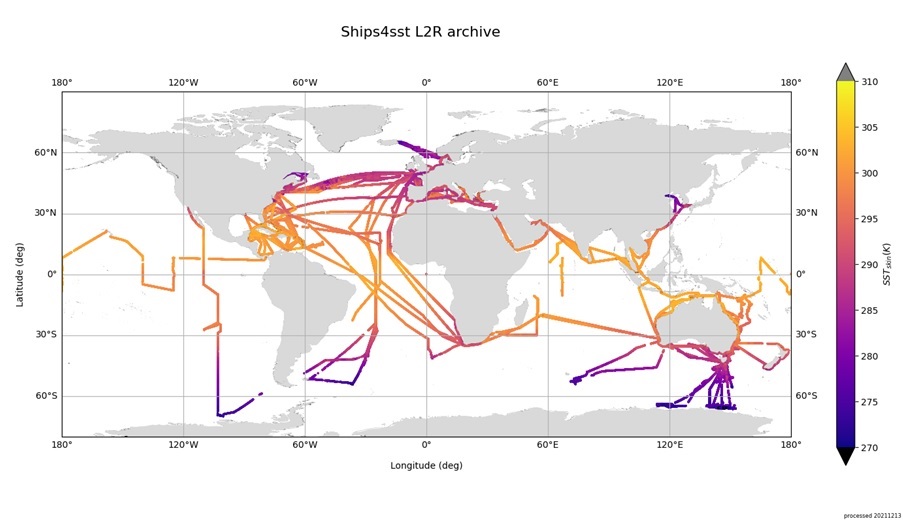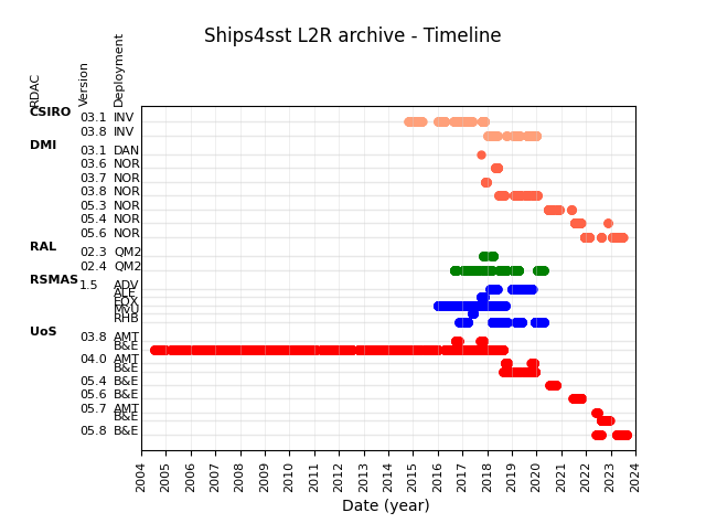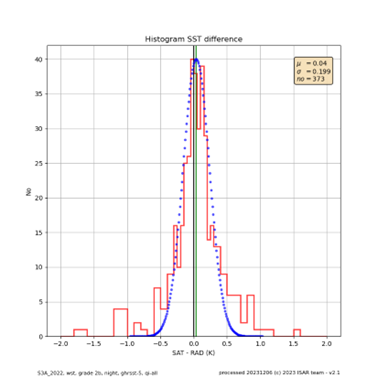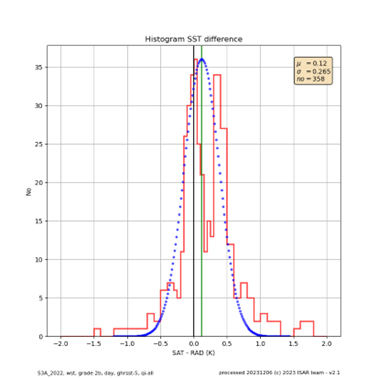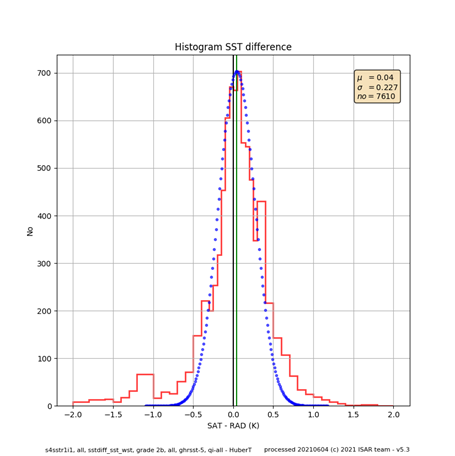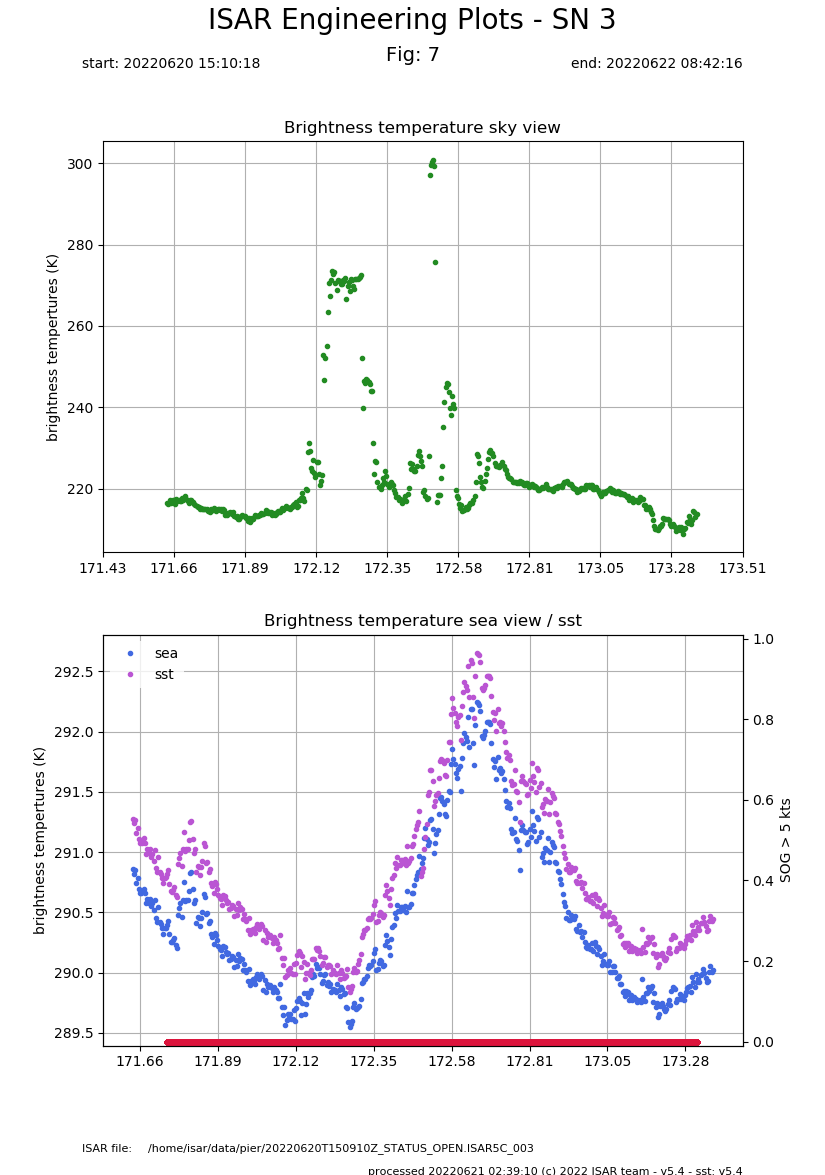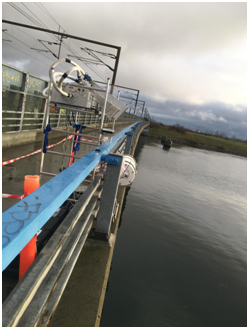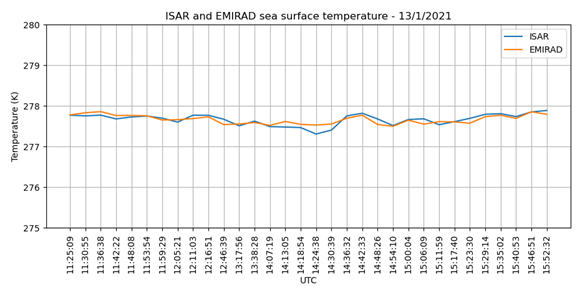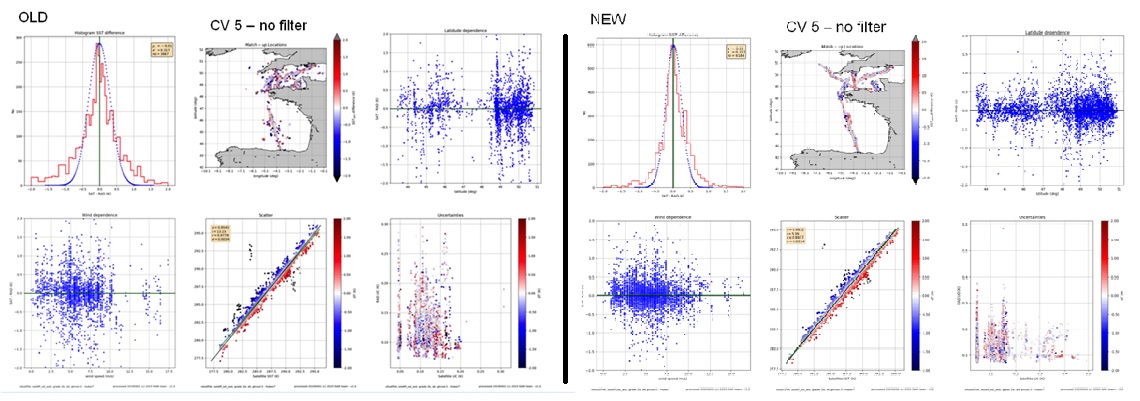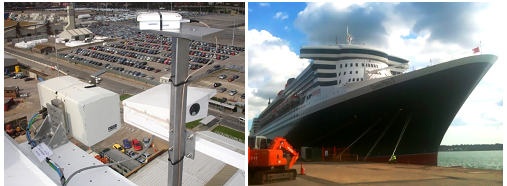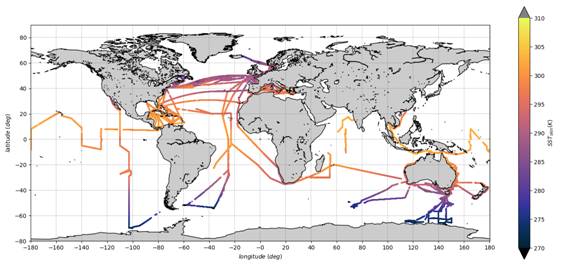Results
In phase 3 of the FRM4SST contract, ESA is building on almost 25 years of continuous Fiducial Reference Measurements (FRM) from UK and ESA-funded shipborne radiometers by establishing a service to provide historic and ongoing FRM measurements to the global Sea Surface Temperature (SST) community, through the International SST FRM Radiometer Network (ISFRN), via ships4sst.
The ships4sst network is open to anyone, and currently comprises of partners from the UK (University of Southampton, Rutherford Appleton Laboratory, Space Connexions Ltd), Denmark (Danish Meteorological Institue) and France (Ifremer), with contributions from the USA (University of Miami, M-AERI) and Australia (CSIRO, ISAR) and not only collects shipborne radiometer data but also uses the data to validate satellite SST products. The ships4sst data is freely available to anyone, as are the validation results.
Figure caption: SST skin data from ships4sst contributors from around the globe.
On this page, we will keep you up-to-date with the results from our project and partners.
-------------------------------------------------------------------------------------------------------------------------------------
April 2024 - Shipborne Comparison of Infrared and Passive Microwave Radiometers for Sea Surface Temperature Observations
The manuscript for the projects IR-MW intercomparison, led by DMI, is now open for discussion at:
EGUsphere - Shipborne Comparison of Infrared and Passive Microwave Radiometers for Sea Surface Temperature Observations (copernicus.org) The findings offer insights to optimise SST intercomparisons, enhancing the synergy between TIR and PMW observations.
March 2024 - Don't forget to sign up for the next ISFRN Workshop, either online or in-person at NOC Southampton!
We have some exciting speakers and attendees signed up for our workshop so far, from NASA, ESA, BoM, EUMETSAT, CSIRO, RAL, NPL, SCL and several universities who all work in SST science. Find out more and register at ships4sst invites you to the... | www.shipborne-radiometer.org .
February 2024 - ISAR data up to the end of 2023 is online
ISAR data up to the end of 2023 is now available on the ships4sst archive. See the graph below for a more detailed breakdown of the data currently on the archive
Figure caption: Timeline of the processed L2R data that is available for download on the ships4sst archive. The lower volume of data in 2021 and 2022 is due to the slow recovery of some shipping operators during and after the COVID lockdowns.
January 2024 - 4th ISFRN Workshop and 25 Year Celebration!
Registration for the 4th ISFRN Workshop is now live! This year, we will be combining the workshop with a '25 years of shipsborne SST validation measurements at NOC' celebration. For more information, click here.
December 2023 - Latest Validation of S3 A & B SST data against ships4sst data
The latest results validating SLSTR A and B SST data against ships4sst data between the years 2020 - 2022, shown by science leader Werenfrid Wimmer at the S3VT Meeting in December 2023, show very good results for SLSTR.
In summary, there is virtually no mean difference at night and only a small difference at day time (see figures). There are some regional differences, and some mean difference, mainly SLSTR 3B D2 data in 2020 and 2021. The Robust Standard Deviation (RSD) is lower at night than day time, and is lower than it was for AATSR.
Figure caption: Sentinel 3A histogram showing the difference in SST data between SLSTR S3A and ships4sst nighttime during 2022. The red lines show the data whilst the dotted blue line shows a Gaussian fit to the median absolute deviation and RSD. The median absolute deviation (µ), RSD (σ) and number of data points (no) are shown in the top right-hand corner of the plot.
Figure caption: Sentinel 3A histogram showing the difference in SST data between SLSTR S3A and ships4sst daytime during 2022. The red lines show the data whilst the dotted blue line shows a Gaussian fit to the median absolute deviation and RSD. The median absolute deviation (µ), RSD (σ) and number of data points (no) are shown in the top right-hand corner of the plot.
For further details and to view a copy of the S3VT presentation, click here.
October 2023 - Phase 3 Kick Off!
The Kick-Off meeting for the next phase of the FRM4SST contract was held on the 24th October. We are very excited to continue our work; gathering high accuracy SST measurements and validating satellite data to FRM and CDR standards. Keep an eye out for the ongoing results of our radiometer deployments and satellite SST data validation, and for information on our next ISFRN workshop!
June 2023 - Phase 2 Final Report
The final report for Phase 2 of the FRM4SST project has been issued. Find out what we have been busy working on for the past 3 years, and how shipborne radiometry helps us to provide the high accuracy surface temperature measurements needed to provide fundamental Climate Data Records (CDRs) for surface temperature measurements. Click here!
May 2023 - CEOS TIR Radiometer Incomparison Results
The team have been hard at work gathering and analysing the data from the thermal-red radiometer intercomparison that took place in the UK in June last year. Visit the CEOS TIR Radiometer Intercomparion page to find out more!
December 2022 - FRM4SST Team show latest results at PM6
The FRM4SST team updated each other with their most recent results at the latest Progress Meeting (PM6). Notably, the latest validation of SLSTR (S3A and S3B) with shipborne FRM data show very good results for SLSTR; there is virtually no mean difference at night and only a small difference at day time (expected as the 3-channel algorithm at night time should perform better than the day time 2-channel algorithm), the RSD is lower at night and comparable to AATSR. These results, along with more details and further analysis, will be included in a project paper due over the coming months.
Figure caption: Example validation results - global histogram showing SST difference (WST - 2019 - GHRSST QL 5 - S3B)
19 October 2022 -FRM4SST Science Lead Werenfrid Wimmer presents
Werenfrid Wimmer presents his 'Sentinel-3 SLSTR SST validation using a Fiducial Reference Measurements (FRM) service' talk this afternoon at the 7th Sentinel-3 Validation Team meeting in Italy. For more details, click here.
9 September 2022 -Thank you to our ISFRN Workshop presenters and participants!
The ISFRN Workshop took place online and at NOCS over the past 2 days. A variety of presenters showcased their work to a global audience, resulting in some very interesting conversations! The FRM4SST project would like to thank all the presenters for their fantastic talks and look forward to hearing more about all the developments and results from the ISFRN and our partners in the future too. To view the presentations from the workshop, visit here.
03 August 2022 -ISFRN Workshop Agenda finalised and pre-registration open!
The final agenda for the ISFRN Workshop is now online on our 2022 ISFRN workshop page. The workshop is taking place virtually and at Southampton (UK) between the 8th - 9th September with speakers from all over the globe. For more details and to register for the workshop, visit the 2022 Workshop page.
27 June 2022 - Congratulations to the participants of the CEOS International Radiometer Intercomparison Exercise
The Radiometer Intercomparison exercise succesfully took place at NPL and at Boscombe bay over the last two weeks. A graph with pleminary results showing a 2.5 K diurnal warming (due to some nice hot weather at Boscombe Pier!) from the project science leader is shown below.
Figure caption: Preliminary results from the Intercomparion on Boscombe Bay Pier
The results from this Intercomparison exercise will be written up in a report by NPL and preliminary results will be presented at the ISFRN Workshop in September 2022.
16 May 2022 - Less than a month to go until the next CEOS International Radiometer Intercomparison Exercise!
The 2022 Infrared Radiometer Intercomparison follows the implementation of 4 highly successful comparisons that took place in Miami and NPL during the past 20 years, and will be the first CEOS intercomparison exercise to take place since 2016. This year, the comparisons will take place in laboratory conditions at the National Physical Laboratory (NPL) and outside on a seaside pier on the south coast of England (Boscombe Bay). The following exercises will be performed: 1. Comparison of the blackbody reference standards used for calibration (laboratory based). 2. Comparison of the radiometer response to common blackbody target (laboratory based). 3. Evaluation of differences in radiometer response when viewing sea surface targets, in particular the effects of external environmental conditions such as sky brightness (field based). These experiments will help us to ensure the accuracy of the radiometers used during in situ collection of Essential Climate Variable (ECV) data such as Sea Surface Temperature (SST), referenced to SI units and Fiducial Reference Measurement (FRM) standards. This is important as consistent “climate quality” data from satellite measurements is generally confirmed through data validation using accurate surface based measurements; field deployed IR radiometers are calibrated traceably to SI standards, generally through a reference radiance blackbody, and so are consistently used for satellite data validation. Therefore, it is essential that any differences in the results obtained between radiometers operated by different teams are well understood and accounted for, so that any potential biases are removed and are not assigned to satellite sensors.
14 April 2022 - ISFRN Workshop: Date Change
The date for the next ISFRN Workshop has been moved to 8 - 9 September 2022, to allow for the presentation of preliminary results from the CEOS TIR radiometer inter-comparison exercise taking place this June. For more details and to register your interest, visit our ISFRN Workshop page.
1 April 2021 - Phase 2 has begun!
We are pleased to announce that Phase 2 of the ships4sst: FRM4SST project has kicked off! For this phase, the consortium has been joined by NPL who will be using their expertise to plan, host and report a CEOS TIR radiometer inter-comparison exercise, the first since 2016 and due to take place in Spring 2022. For a summary of all our current and future activities visit our Project Tasks page.
1 February 2021 - WP70: Preparation of MW/TIR Experiments
Since July 2020 the Danish Technical University (DTU) has been working on the refurbishment of a passive microwave (PMW) radiometer in preparation for a short land-based demonstration of simultaneous deployment of thermal infrared and microwave radiometers. In January this year DMI conducted the demonstration on a small bridge in Copenhagen (see image), with one ISAR deployed alongside two microwave radiometers for C-band and X-band measurements. Initial results show good agreement between the IR and PMW observed SSTs, as seen in the graph shown below.
Figure 1: The radiometers supported by scaffolding as part of the demonstration over a bridge in Copenhagen.
Figure 2: The temperature comparison between ISAR and EMIRAD (the two microwave radiometers).
31 October 2020 - The ISFRN workshop took place online on the 17 - 18th September with talks on the results and progress of in situ radiometer deployments, calibration and validation and how the data is used in practise. The project would like to thank and acknowledge all the presenters for their fantastic talks over the two days of the workshop. Recordings are now online.
1 September 2020 - WP60: Plan a CEOS International TIR Inter-comparison Exercise
Our WP 60 team have been busy reviewing the lessons learnt from the 2016 inter-comparison exercise, to help plan the next international TIR radiometer inter-comparison. We are also in discussion with colleagues regarding the set up of a 2021/2022 laboratory inter-comparison. Our lead scientist, Werenfrid Wimmer, will be presenting plans for the future inter-comparison exercise at our ISFRN workshop on the 18th September.
3 August 2020 - WP80: Study for a next generation radiometer
Last month, the team began a package of work set to define the next generation of ship radiometers, to provide continued high-quality validation of satellite measurements now and in the future. We are currently assessing the design of current instruments and working through the needs of the SST community, so that a clear specification of a new and improved radiometer can be produced! See our Tasks page for more information.
9 July 2020 - The team is excited to begin work on several new work packages this month. They include planning for an international CEOS thermal infrared (TIR) radiometer inter-comparison, undertaking a study for a future generation radiometer and conducting a pilot study to compare measurements of TIR and microwave SST in cold waters.
2 June 2020 - Our science leader, Werenfrid Wimmer, presented the results of his SST validation work to the GHRSST community today. The results of the validation of SLSTR data using ships4sst data indicate that SLSTR is performing very well with virtually no mean difference between the SLSTR and FRM data at night and only a small difference during the day.
5 May 2020 - Details for the next ISFRN workshop are now online! This workshop is now completley virtual, please join us for the latest information on shipborne radiometers and the verification and uses of SST skin data.
27 April 2020 - Deployments for ISAR (Uos) and SISTeR are currently on hold whilst ships remain in port during the Covid-19 pandemic. It is currently unknown when deployments will resume but our operators are keeing in close contact with their respective ships of opportunity to keep up-to-date with the latest deployment schedules.
16 March 2020 - The Felyx processor version has been updated recently to v4.0/r1i1. This has resulted in better validation results; a comparison can be seen in the figures shown below.
17 February 2020 - Our Science Lead, Werenfrid Wimmer, presented at the Oceans Science Meeting in San Diego, USA today. He showed examples of the ships4sst data and demonstrated its use with the newest SLSTR validation results from the ships4sst network regions; showing that SLSTR performs at least as well as its predecessor AATSR. Results of the SLSTR A and B units during the Sentinel-3 tandem phase in 2018 were also shown by using triple collocations on the ships4sst FRM data and the SLSTR units on Sentinel 3 A and B. More information can be found on the poster here.
5 September 2019 - Does it matter where you place your shipborne radiometer when you do FRM observations of SST? Yes it does!
Measurements made by a thermal camera mounted on a drone by the DMI group during a cruise revealed that it does indeed make a large difference whether the radiometer measures on disturbed water or waters not affected by the ships wake. The figures below show the radiometric temperature fields as observed from two locations onboard the ship. Figure 1 is taken from the front of the ship where the DMI ISAR is mounted and shows a small spatial variation within the field of view.
Figure 1: thermal readings of the water taken by the drone at the front of the ship
Figure 2 is taken from the starboard side of the ship and shows how the observed temperature varies significantly through the field of view. The variation is mainly due to different emissivities for the foam and calm waters.
Figure 2: thermal readings of the water taken by the drone at starboard
Such investigations are very helpful to ensure the quality and traceability of the SST FRM observations taken within the FRM4SST project, which are used to validate satellite SST products to FRM standards.
31 July 2019 - Our DMI experts have been using drone technology to observe the spatial SST field around the M/S Norrona. For more information follow our DMI lead scientist at https://twitter.com/JacobHoeyer
30 June 2019 - Our shipborne radiometers have continued on their deployments on the Pont Aven, M/S Norrona and the Queen Mary 2. Visit our deployments page for links to the current location of the instruments. A photograph of the SISTeR instrument mounted on the Queen Mary 2 is shown below.
1 May 2019 - The next stage of the ships4sst project, the ESA-funded FRM4SST contract beings today,with the aim of continuing the ISAR and SISTeR deployments, validating satellite SST data from SLSTR and other instruments and furthering the ISFRN development.
31 March 2019 - Today marks the end of the first Ships4sst contract and we look forward to the next phase of the ESA-funded contract starting in May. For now, here is a world map showing the SST radiometer data gathered by our colleagues and currently stored in our archives (accessible via this website). Further information can be found in our Final Report.
Figure caption: The ships4sst data archive L2R files plotted as SST on the world map
28 February 2019 - The ISFRN workshop finished today with a number of successful presentations from prominent scientists within the SST radiometer community and a group discussion in which strategies for taking the ISFRN forward were discussed. Presentations can be found on the documents page and more information on the workshop can be found on the workshop page.
20 September 2018 - Details for the upcoming ISFRN Workshop have been posted online at http://www.shipborne-radiometer.org/news/isfrn-workshop.
5 April 2018 - A new contract, "Copernicus SLSTR SST Validation using Fiducial Reference Measurements" (aka "ships4sst") has kicked off today. This is an ESA contract with the University of Southampton, RAL Space, DMI and Space ConneXions, which is designed to continue the skin SST measurements from ISAR and SISTeR that were previously funded by BEIS and its predecessor departments since 2004. The new project falls under the EU Copernicus programme and as intended to support the tying together, to a common internationally recognised reference standard, of climate quality SST measurements from AATSR and SLSTR so that the long-term SST time series started by the ATSR sensors may be continued by SLSTR. The ships4sst contract will continue until 31 March 2019, when the UK's role in the Copernicus programme following Brexit is expected to be clarified.
